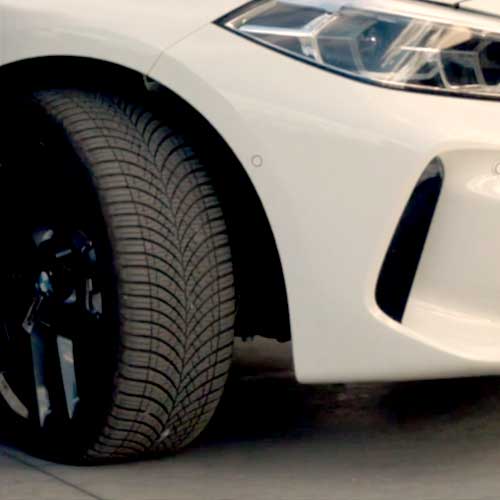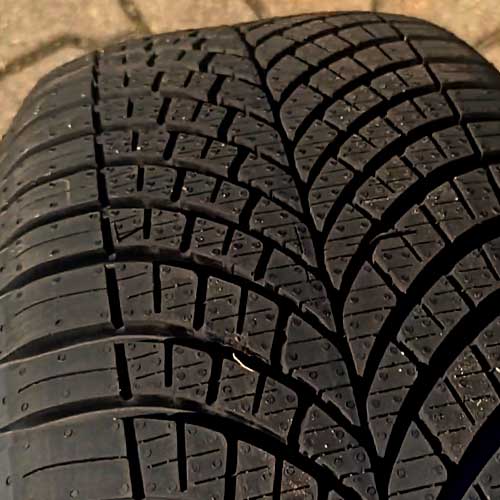Goodyear Vector 4Seasons Gen 3 is a grand touring all-season tire that is built for drivers of sedans, coupes, crossovers, and SUVs. This tire made some significant improvements over Gen2, and now offers a stiffer inner construction, that allows it to be one of the best tires out there in terms of cornering stability.

Being a tire engineer, from my perspective, the Goodyear Vector 4Seasons Gen 3 is a very capable tire, where it shines on dry roads with it’s remarkable performance, that’s the most highlighting feature of this tire. Still, the tire is not going to disappoint at all on wet roads even, where it’s very close to the most hydroplaning resistant tire out there. However, the overall snow traction could be improved, but considering the rest, that can be overlooked. I highly recommend this tire.
Let’s start things off with a quick run down of this tire.
The good things about this tire:
- Best dry handling compared to other premiums in the market.
- Good float speeds indicating resistance to hydroplaning.
- Very satisfactory wet performance.
The not so good things about this tire:
- Not as fuel efficient.
- Snow performance should have been better.
- Comfort of the tire can be improved.
Sizes – What to Know?
So overall, the Goodyear Vector 4Seasons Gen 3 comes in 75 total sizes, in 14 to 20 inches. All of its sizes have following main specs, you should know.
- Speed ratings: H, V, W and Y.
- Load ratings: SL and XL.
- Weight range: 16 to 26 lbs.
- Tread depth: 10/32″ on all.
- UTQG: 500 A A.
- Treadwear warranty: 5 year standard.
- All sizes have 3PMSF ratings.
Compare Goodyear Vector 4Seasons with others:
- Hankook Kinergy 4S2
- Michelin CrossClimate 2
- Bridgestone Turanza All Season 6
- Continental AllSeasonContact 2
Tread Appearance
Goodyear Vector 4Seasons Gen 3 forms a directional pattern with arrow shaped lugs.

If we start things off from the shoulder blocks, the tire offers a very plain design here, especially when you compare it with the rest.
Here very minimal siping is seen and the lateral spacing between the blocks is widest.
Besides grooves made by these arrow shaped lugs, the tire features 3 circumferential channels as well.
All these channels are interconnected with each other with slanted grooves/cuts in the lugs and they enhance the tire’s resistance to aquaplaning.
In the middle the tire makes maximum contact with the surface.
That’s because here the lugs are closely packed and the tire has a rounded shape.
Durability/Internal Construction
Durability is worth discussing at the start, as the tire’s internal structure has a large role to play in overall performance.
The inner construction of Goodyear Vector 4Seasons Gen 3 contains 2 layers of polyester casing (the skeleton of the tire) making 2 ply sidewalls.
The casing has 2 high strength steel belts running on top, and these belts are then layered with another polymer, poly-amide.
Mostly all season tires have same inner construction like that, but what makes Goodyear different here is it’s stiffer inner construction, that makes the sidewalls more stable. That’s why the tire offers one of the best handling times out there. I’ll talk about it more below.
Dry Performance
Dry performance is not that difficult, but still all season tires sometimes have to face a hard time here. That’s because these tires have to be optimized for all types of weathers and a wide range of temperature conditions.
Though with a superior thermally adaptive rubber (that’s doesn’t go too soft in summers, on dry pavements, also keep the heat production low.
So while it’s lugs staying firm, add to the tire’s stability, whereas it’s countless features regarding tread design ensure the needed traction.
Let’s check both of these factors.
Dry Traction
Dry traction in tires involves two key components: directional grip and lateral traction.
The directional grip, which is gauged by the tire’s braking efficacy, benefits from the design featuring tightly packed central lugs.
This structure ensures substantial contact between the rubber and the road surface.
Additionally, the tire incorporates numerous biting elements, where its grooves function as in-groove notches, and even though the sipes are primarily intended for wet conditions, they also contribute to the tire’s linear grip by flexing and gripping the road surface.
This design results in a robust overall directional grip. While it may not match the top-performing Crossclimate 2 (review) in this aspect, the difference is marginal.
In terms of lateral grip, this tire only excels, but is leading at the very top, as seen particularly in tests measuring lateral G-forces.
This superior performance is largely attributed to the tire’s shoulders.
As the weight shifts to the shoulders during turns, the minimal tread features there (consisting mainly of a single sipe per block) allow for an exceptional contact patch, enhancing grip.
Furthermore, the tire’s longitudinal grooves play a vital role in lateral grip. They contract and expand as the tire turns, effectively biting into the road surface and providing additional traction in sideways movements.
Steering Response
Now steering response is the final piece of the puzzle, when it comes to “overall handling”.
And as already seen, the tire here offer best lateral grip, among its direct competitors, and that combined with it’s quickest steering responsiveness, you get the tire which leads the grand touring all season category (in terms of overall handling).
In fact that’s the main reason, why I added the tire in my list of top grand touring AS tires.
Now, the Goodyear Vector 4Seasons Gen 3 is a very vocal tire, which provides very quick response, where even the smallest of inputs on the steering yields fast and sporty response.
Now here the tire greatly helped by two things, it’s lighter weight (thanks to it’s firmer internal construction), and rounded contact patch.
The firmer construction, keep the lugs composed while the tire turns, keeping sidewalls from flexing a lot (which disrupts the over/under-steering balance.
While the rounded contact patch shift the weight on the tire form middle, towards shoulders (and vice versa) in a more streamlined manner, adding to the tire’s overall stability.
Wet Performance
Just like the dry performance, the wet performance of the tire is also very satisfactory and sporty. The tire only slightly lacks to the Vredestein Quatrac Pro (review), which I’ve ranked for the best for wet roads in my list of all season tires.
Let’s see why, discussing the two main wet road performance factors, traction and hydroplaning.
Wet Traction
The Goodyear Vector Gen3 basically provides very efficient water cleaning capabilities, so this helps sipes, as a lot of burden is lifted off them. Let me explain.
Water is in-compressible. So if there is water between the rubber and the road, loss of traction would occur, so the whole focus is to clear water out of the path. And to handle that, there are 2 major areas, grooves and sipes.
As the tire comes in contact with the wet surface, most of the water gets squeezed out in to the grooves, but a little remains stuck in between and that’s where sipes help as they offer slits where vacuum is created, so they suck in the rest of the water and spray it out when the tire rolls over.
So if the grooves are efficient enough, very less amount of water would get stuck under the sipes.
Another plus point for this tire is that, it’s filled with uncountable sipes in the first place, so these rectilinear sipes make sure all water underneath is wiped away efficiently.
Hydroplaning Resistance
The resistance to hydroplaning of the tire is measured by calculating the water evacuation capability of a tire.
So, as I discussed above, the Goodyear Vector 4Seasons Gen 3 provides very effective channels where water can escape without any trouble, so the tire has no problem in this area.
The curved lugs of the tire make tread voids, which are also interconnected with others, so water gets a network of channels to escape the tire fast. So you get very nice float speeds of up to 50 mph.
For Your Info: Hydroplaning resistance is often underrated in analyzing the tire’s overall wet traction. It’s very important, because the more water the tire channels out, the less water there is for the sipes to wipe away. In other words, with better hydroplaning, the tire also improves the sipes efficiency, enhancing overall wet traction.
Winter Performance
The directional design of the tire with elongated lugs provide efficient traction on snow, slush and ice as they scoop them up as the tire rolls. Lugs push back the snow and form forward momentum of the tire.
So the tire provides good enough acceleration values which earns it 3 Peak Mountain Snowflake rating symbol. But compared to other top tier tires, it’s not that good.
The tire where forms a solid grip on roads, compromises on snow a little bit as it’s stiffer compound does not give the tread of the tire flexibility which is highly crucial on snowy terrains.
Road Noise
Directional tires deal with noise in a better way. And with Goodyear tires mostly, the shoulder blocks are slightly elevated on the corners due to the tire’s rounded contact with the ground (instead of making rectangular footprint).
This helps because noise is just air, and most of that air which converts in to tread noise enters through the shoulders. The Goodyear Vector 4Seasons Gen 3 offers open shoulder blocks where air is more free to roam, so it’ does not collide with the tread walls as aggressively.
So that begs the question, why not all tires out there have directional pattern? Well, because the manufacturing of such a pattern is not cheap, that’s why these tires are expensive.
For Your Info: The Goodyear Vector GEN 3 noise levels is on par with premium summer tires.
Impact Comfort
The comfort of the tire has a lot to do with the tire’s composition. A softer compound is better able to absorb the bumps, whereas on a stiffer rubber, you get a jittery ride.
Goodyear Vector 4Seasons Gen 3 does not provide as much subjective comfort as its internal structure of nylon cap plies and 2 ply sidewalls makes this tire a little stiff, so the vibrations are not dissipated off in the tread as efficiently.
One of the best tire for comfort, is Michelin Crossclimate 2, as it offers a very soft silica rich rubber compound which is very effective at diminishing the vibrations of imperfections on the road.
Tread Wear and Fuel Efficiency
Goodyear Vector 4Seasons Gen 3 is a very effective tire in terms of wear. The tire on average offers 40k plus miles which is great given that its a high performing all season tires.
Usually tires which have more traction on roads have higher grip and rolling resistance.
High rolling resistance means more wear. But this tire where it’s one of the best performing on dry roads, still offers a rubber that’s very resistant to wear.
But since this high rolling resistance is directly linked with fuel usage, the tire isn’t able to provide you with a good enough economy, overall.
Take Home Points
Goodyear Vector 4Seasons Gen 3 is a great all season tire which is capable of handling dry and wet roads in both summers and winters.
The tire gives you a great dynamic response and communicates with the steering really well. The most highlighting feature of this tire is it’s handling performance on dry asphalts. But this comes at a little cost, literally too, as the tire with such high grip, also produces high rolling resistance values.
So with more rolling resistance, the tire consumes more fuel.
But the good thing is, it lasts a long time, as it’s stiff compound is less prone to wear comparatively.